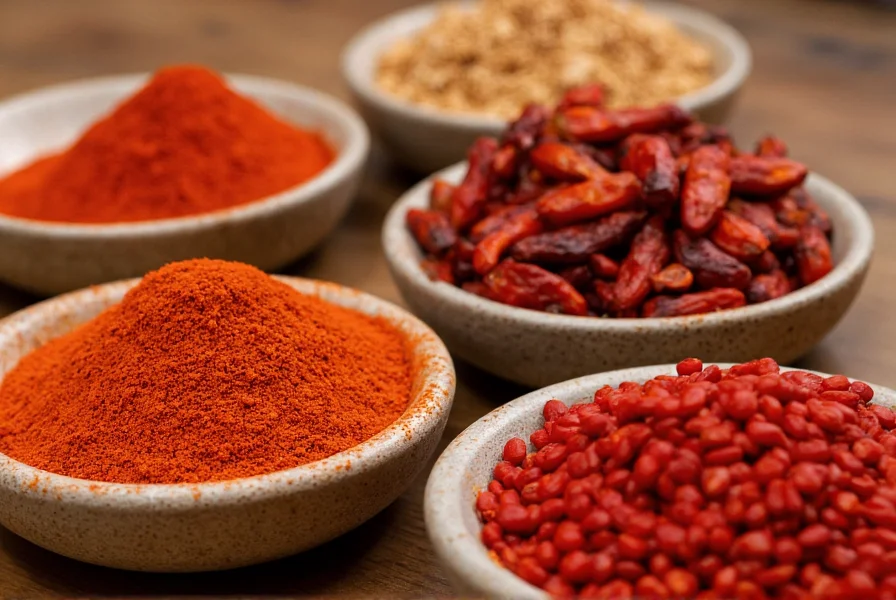Running out of red pepper flakes mid-recipe can derail your cooking plans, but numerous effective alternatives exist in most kitchens. Whether you need an exact heat match, a milder option, or something with complementary flavor notes, understanding proper substitutions ensures your dishes maintain their intended character without compromising quality.
Why You Might Need a Red Pepper Flakes Substitute
Home cooks seek red pepper flakes replacements for various practical reasons: dietary restrictions, unavailable ingredients, or simply wanting to experiment with different heat profiles. Unlike many spice substitutions, replacing crushed red pepper requires attention to both heat level and flavor complexity, as it contributes both spiciness and subtle fruitiness to dishes.
Top Red Pepper Flakes Alternatives Compared
Understanding the heat scale and flavor profiles of potential substitutes helps you make informed decisions. The following comparison details the most accessible alternatives:
| Substitute | Heat Level (Scoville) | Substitution Ratio | Flavor Profile | Best Used In |
|---|---|---|---|---|
| Cayenne Pepper | 30,000-50,000 | 1:2 (1/4 tsp cayenne = 1/2 tsp flakes) | Sharp, direct heat | Sauces, marinades, dry rubs |
| Aleppo Pepper | 10,000-15,000 | 1:1 | Fruity, moderate heat, slight saltiness | Mediterranean dishes, roasted vegetables |
| Crushed Guajillo | 2,500-5,000 | 1.5:1 | Berry-like, mild heat | Stews, soups, Mexican cuisine |
| Hot Sauce | Varies widely | 1/2 tsp per 1/2 tsp flakes | Vinegary, liquid consistency | Quick sauces, dressings, finishing |
| Smoked Paprika | 0-2,500 | 1:1 (plus pinch cayenne) | Smoky, earthy, minimal heat | BBQ recipes, roasted meats, deviled eggs |
How to Substitute Red Pepper Flakes Properly
Successful substitution requires understanding both heat equivalence and flavor compatibility. The Scoville scale measures capsaicin concentration, but flavor notes significantly impact your dish's final character. When replacing red pepper flakes:
- For pizza and pasta dishes: Crushed Calabrian chilies provide similar texture with a fruitier profile
- For baking applications: A blend of paprika and cayenne maintains consistent heat distribution
- For finishing dishes: Fresh Thai bird chilies offer vibrant color and immediate heat
- For sensitive palates: Sweet paprika with a dash of black pepper creates complexity without intense heat
Always add substitutes gradually, tasting as you go. Dried alternatives intensify when cooked, while fresh chilies provide more immediate heat that mellow slightly during cooking.
Specialized Substitutions for Specific Cuisines
Different culinary traditions benefit from tailored alternatives that maintain authentic flavor profiles:
Italian cooking: Crushed dried oregano stems with a pinch of cayenne mimics the herbal notes in traditional Italian red pepper flakes. The stems contain concentrated flavor compounds often discarded but perfect for substitution.
Asian recipes: A combination of Chinese five-spice powder (1/4 tsp) and white pepper (1/8 tsp) replaces both heat and the subtle complexity red pepper flakes would provide in fusion dishes.
Mexican cuisine: Toasted and crushed guajillo or pasilla peppers offer the earthy depth missing in standard red pepper flakes, better matching regional flavor expectations.

Storage Tips for Alternative Ingredients
Proper storage maintains potency of substitute ingredients. Keep dried alternatives in airtight containers away from light and heat. Ground spices lose potency faster than whole dried chilies - consider keeping small quantities of dried arbol or pequín peppers specifically for crushing as needed. Freeze fresh chili peppers on a baking sheet before transferring to freezer bags to prevent clumping.
When substituting in recipes requiring long cooking times, add dried alternatives early to allow flavors to develop, while fresh chilies work best added in the last 10-15 minutes to preserve their bright heat characteristics.
Common Mistakes to Avoid
Cooks often make these errors when substituting red pepper flakes:
- Using equal amounts of cayenne without adjusting for higher heat level
- Adding substitutes too late in cooking, resulting in raw, harsh heat
- Ignoring flavor compatibility (e.g., using smoked paprika in delicate seafood dishes)
- Substituting fresh chilies in equal volume to dried (fresh requires 3x quantity)
Understanding these pitfalls helps maintain recipe integrity when your preferred crushed red pepper isn't available.

Creating Your Own Custom Blend
For frequent cooking needs, create a versatile homemade alternative by combining:
- 2 parts crushed dried arbol chilies (for heat)
- 1 part crushed dried guajillo (for fruitiness)
- 1/2 part dried oregano (for herbal notes)
- 1/4 part garlic powder (for depth)
Store this blend in an airtight container for up to six months. This mixture closely replicates commercial red pepper flakes while allowing customization for personal heat preferences.
Frequently Asked Questions
Can I substitute paprika for red pepper flakes?
Yes, but standard paprika lacks heat. Use smoked paprika for depth and add 1/8 teaspoon cayenne per teaspoon of paprika to approximate red pepper flakes' heat level. This creates an effective paprika substitute for red pepper flakes in most recipes.
What's the best mild alternative to red pepper flakes?
Sweet paprika combined with a small amount of black pepper creates a mild red pepper flakes alternative that provides similar color and subtle complexity without intense heat. For slightly more heat, use Hungarian paprika which has moderate warmth without overwhelming spiciness.
How do I substitute fresh chili for red pepper flakes?
Use three times the volume of finely minced fresh chili compared to red pepper flakes. For example, replace 1/2 teaspoon red pepper flakes with 1 1/2 teaspoons minced serrano or jalapeño. Remember that fresh chilies provide immediate heat that mellow slightly during cooking, unlike dried flakes which intensify.
Can I use chili powder instead of red pepper flakes?
Yes, but standard chili powder contains additional spices. Use 3/4 teaspoon chili powder per 1/2 teaspoon red pepper flakes, and reduce other spices in your recipe slightly. For a closer match, make your own chili powder using just dried chilies without additional seasonings.
What's the difference between red pepper flakes and crushed red pepper?
These terms are often used interchangeably, but technically red pepper flakes typically contain a blend of辣椒 varieties including cayenne, while crushed red pepper may refer to a single variety. The heat level and flavor profile can vary between brands, so substitution ratios might need slight adjustment based on your specific product.











 浙公网安备
33010002000092号
浙公网安备
33010002000092号 浙B2-20120091-4
浙B2-20120091-4